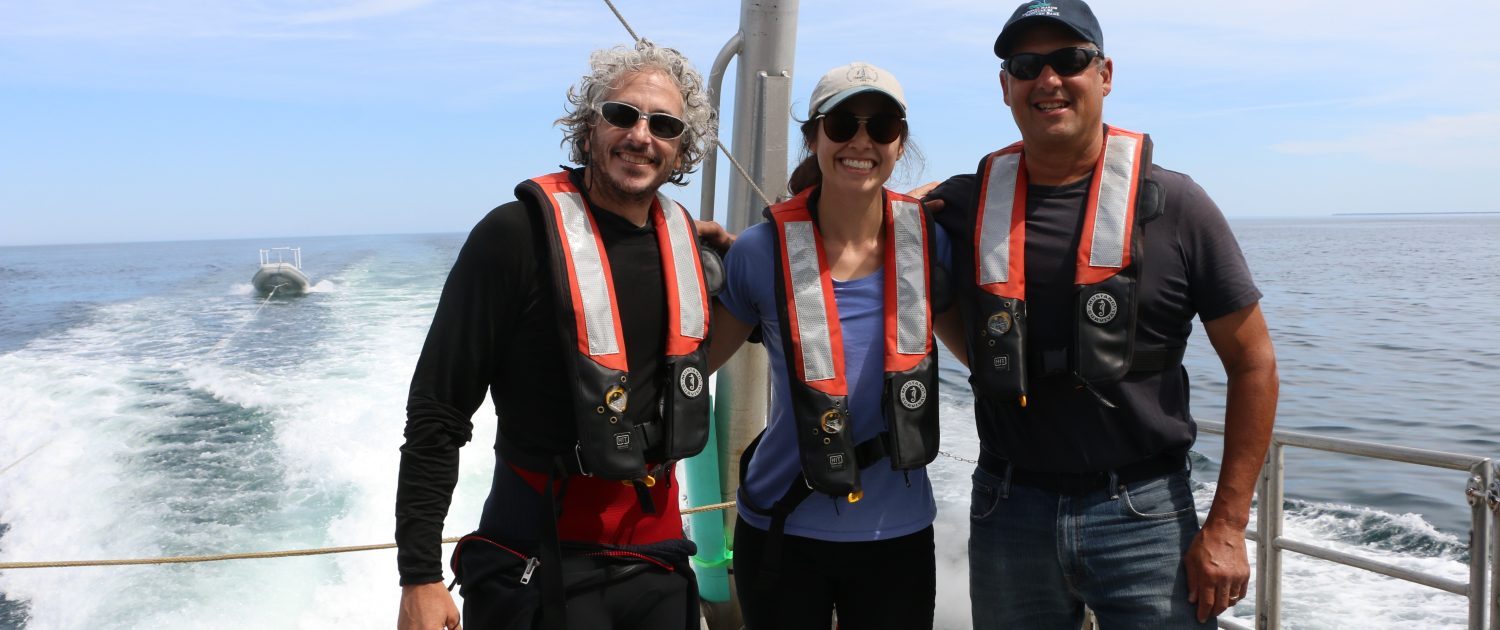Space to Sea Shares Stellwagen Bank National Marine Sanctuary’s Mission to Inspire the Public

MIT Sea Grant visiting artist Keith Ellenbogen explores Stellwagen Bank National Marine Sanctuary through compelling visual images and environmental storytelling aboard NOAA’s Research Vessel Auk.
Just before 5:30 am on August 12, Keith Ellenbogen arrived in the early morning twilight at the NOAA Stellwagen Bank National Marine Sanctuary (SBNMS) headquarters in Scituate, MA. Carting his numerous cameras and dive gear to the dock, Ellenbogen met up with a team of seafarers, including the captain of NOAA’s Research Vessel Auk, Amy Meloski, and the superintendent of the sanctuary, Peter DeCola. The 50-foot research catamaran was designed to support the science and educational missions of the sanctuary, from cod and haddock spawning research with MIT Sea Grant, to seabird observations with Massachusetts Audubon and shipwreck investigations with Woods Hole Oceanographic Institution. Captain Meloski took the helm for nearly all of the 113 days that the Auk put to sea this year.
On this particular day, the Auk and its crew were on a mission guided by Ellenbogen to photograph humpback whales and other iconic species within Stellwagen Bank National Marine Sanctuary. Ellenbogen was awarded an Ernest F. Hollings Ocean Awareness Award from the National Marine Sanctuary Foundation to capture dramatic and beautiful images that showcase the surprising diversity of marine wildlife within this marine protected area, just 25 nautical miles off the coast of Boston, between Cape Ann and Cape Cod. Joining for the day’s activities was Julia Mason, a John A. Knauss marine policy fellow currently working in MA Senator Ed Markey’s office. Mason, a recent Ph.D. graduate from Stanford University’s Hopkins Marine Station, connected with Ellenbogen through his engagements during Capitol Hill Ocean Week in Washington, D.C.
On board, Ellenbogen and DeCola introduced Julia to the region’s representative marine life and relied on her ability to spot whales and dolphins during the marine photography expedition. The sanctuary’s Post Doc Scientist Tammy Silva, Ph.D. explained to the group of spotters that the shape and size of a blow is distinctive to each species: finbacks have a tall, columnar blow; right whales generate a distinctive V-shaped spout; and humpbacks produce a more bushy display. Clocking nearly 10 hours on the Auk, Mason was also able to discuss research and regulations within the sanctuary with Superintendent DeCola. Mason’s research focuses on the social-ecological resilience of fisheries, and dynamic management approaches to protect highly migratory species.

GeoZUI4D – GeoZUI4D is a software application developed at the University of New Hampshire’s Advanced Visualization Laboratory for interacting with time-varying geospatial data. When combined with data derived from the DTAG, it allows the creation of a virtual whale that moves in the exact manner of the tagged whales. Credit: Colin Ware, UNH
The sanctuary is home to the longest running whale tagging research program in the world, collecting a treasure trove of data since 2004. Collaborating with federal and academic scientists from NOAA Fisheries, WHOI, UNH, and other organizations, the project uses acoustic recording tags and customized software to visualize how the whales use the entire water column, and how human activities, like shipping and commercial fishing, may impact their behavior.
At one point, a pod of well over 100 Atlantic white-sided dolphins surrounded the Auk, with Ellenbogen immersed in the action. Throughout the day, Silva maneuvered a smaller boat to position the underwater photographer harmoniously with the movement of the marine mammals. Note: Keith has the first ever permit to attempt underwater photography of whales in New England waters. Underwater photography within New England waters is challenging, as the weather conditions are difficult. The seas can be rough and the water visibility is typically only 10-15 feet. Additionally, the whales are active and feeding in these waters, which makes underwater photography extremely difficult — but essential for raising awareness.

Atlantic white-sided dolphins swim nearby, from a pod of over 100. This photograph was captured by Keith Ellenbogen with NOAA Marine Mammal Photography Permit #21170 in Stellwagen Bank National Marine Sanctuary.
Silva, whose post-doctoral research focuses on marine mammal and prey species interactions, was able to describe in words what only Ellenbogen is able to visualize below the surface. With hydrodynamic dives towards the sandy bottom, the humpback whales were feeding on burrowing sand lance, a critical prey species that also feeds many of the important commercial fishes in the Gulf of Maine. Superintendent DeCola relates that his role is really about protecting the sanctuary’s marine life and local community livelihoods. With an Advisory Council twice the size of the Sanctuary’s staff, DeCola explains, “The public drives what we do.” And it’s projects like Ellenbogen’s that have the ability to bring the public beneath the surface, connecting the community with iconic species in our local waters, and inspiring stewardship for this special underwater park – New England’s only National Marine Sanctuary.



